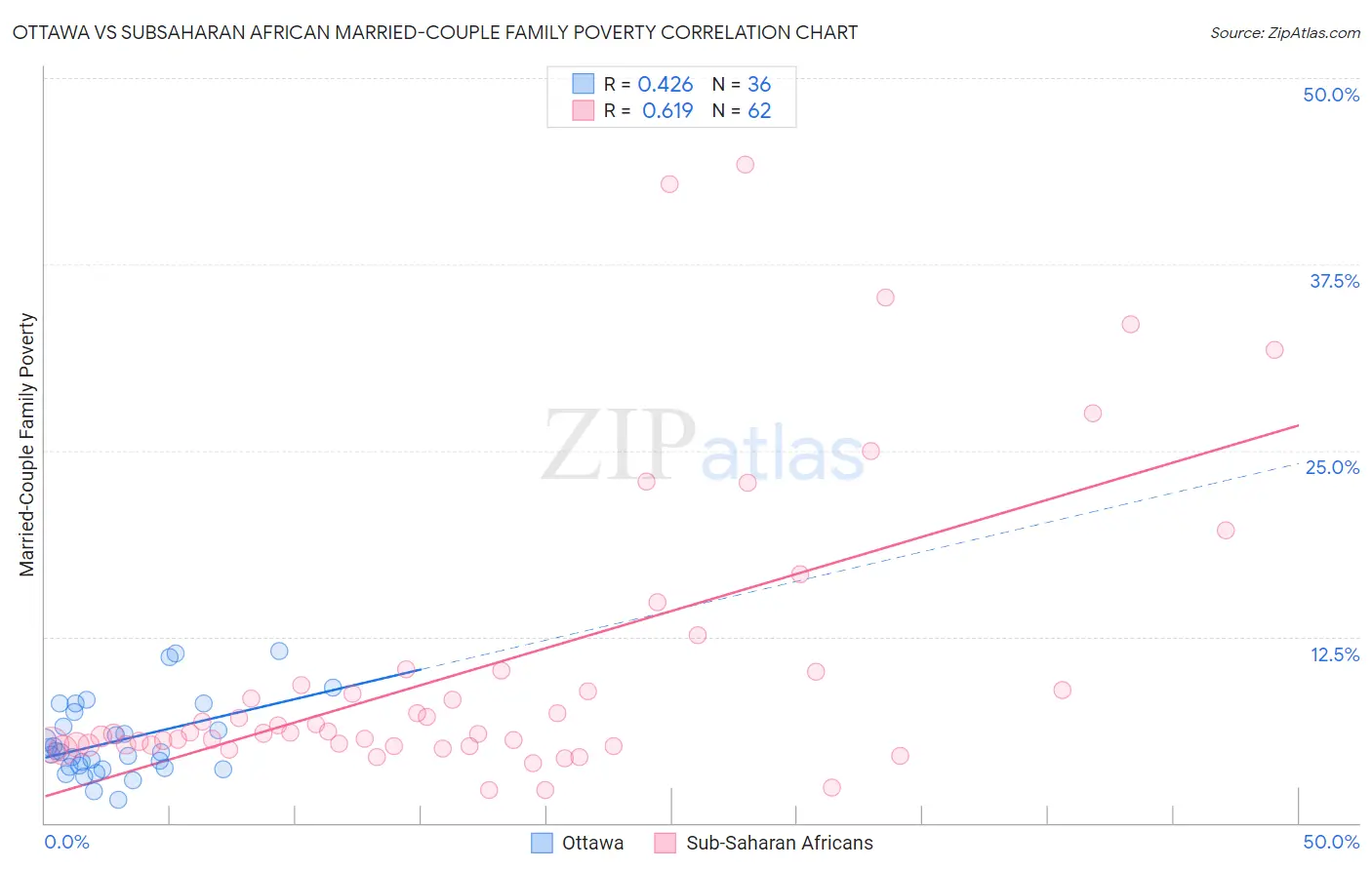Ottawa vs Subsaharan African Married-Couple Family Poverty
COMPARE
Ottawa
Subsaharan African
Married-Couple Family Poverty
Married-Couple Family Poverty Comparison
Ottawa
Sub-Saharan Africans
5.2%
MARRIED-COUPLE FAMILY POVERTY
54.5/ 100
METRIC RATING
169th/ 347
METRIC RANK
5.7%
MARRIED-COUPLE FAMILY POVERTY
4.9/ 100
METRIC RATING
229th/ 347
METRIC RANK
Ottawa vs Subsaharan African Married-Couple Family Poverty Correlation Chart
The statistical analysis conducted on geographies consisting of 49,836,436 people shows a moderate positive correlation between the proportion of Ottawa and poverty level among married-couple families in the United States with a correlation coefficient (R) of 0.426 and weighted average of 5.2%. Similarly, the statistical analysis conducted on geographies consisting of 501,239,511 people shows a significant positive correlation between the proportion of Sub-Saharan Africans and poverty level among married-couple families in the United States with a correlation coefficient (R) of 0.619 and weighted average of 5.7%, a difference of 9.2%.

Married-Couple Family Poverty Correlation Summary
| Measurement | Ottawa | Subsaharan African |
| Minimum | 1.6% | 2.2% |
| Maximum | 11.5% | 44.2% |
| Range | 10.0% | 42.0% |
| Mean | 5.5% | 10.4% |
| Median | 4.8% | 6.1% |
| Interquartile 25% (IQ1) | 3.7% | 5.2% |
| Interquartile 75% (IQ3) | 7.0% | 10.1% |
| Interquartile Range (IQR) | 3.3% | 4.9% |
| Standard Deviation (Sample) | 2.5% | 9.8% |
| Standard Deviation (Population) | 2.5% | 9.7% |
Similar Demographics by Married-Couple Family Poverty
Demographics Similar to Ottawa by Married-Couple Family Poverty
In terms of married-couple family poverty, the demographic groups most similar to Ottawa are Immigrants from Argentina (5.2%, a difference of 0.010%), Immigrants from Uganda (5.2%, a difference of 0.040%), Bermudan (5.2%, a difference of 0.19%), Immigrants from Northern Africa (5.2%, a difference of 0.37%), and Alsatian (5.2%, a difference of 0.39%).
| Demographics | Rating | Rank | Married-Couple Family Poverty |
| Immigrants | Jordan | 66.5 /100 | #162 | Good 5.1% |
| Sierra Leoneans | 64.1 /100 | #163 | Good 5.1% |
| Hawaiians | 62.3 /100 | #164 | Good 5.1% |
| Immigrants | Malaysia | 62.2 /100 | #165 | Good 5.1% |
| Paraguayans | 61.5 /100 | #166 | Good 5.1% |
| Costa Ricans | 61.5 /100 | #167 | Good 5.1% |
| Immigrants | Uganda | 54.9 /100 | #168 | Average 5.2% |
| Ottawa | 54.5 /100 | #169 | Average 5.2% |
| Immigrants | Argentina | 54.4 /100 | #170 | Average 5.2% |
| Bermudans | 52.9 /100 | #171 | Average 5.2% |
| Immigrants | Northern Africa | 51.3 /100 | #172 | Average 5.2% |
| Alsatians | 51.2 /100 | #173 | Average 5.2% |
| Immigrants | Eastern Africa | 50.0 /100 | #174 | Average 5.2% |
| Marshallese | 47.9 /100 | #175 | Average 5.2% |
| Menominee | 47.8 /100 | #176 | Average 5.2% |
Demographics Similar to Sub-Saharan Africans by Married-Couple Family Poverty
In terms of married-couple family poverty, the demographic groups most similar to Sub-Saharan Africans are Moroccan (5.7%, a difference of 0.030%), Arab (5.7%, a difference of 0.25%), Immigrants from Iraq (5.7%, a difference of 0.29%), Immigrants from Laos (5.7%, a difference of 0.35%), and Immigrants from Zaire (5.6%, a difference of 0.38%).
| Demographics | Rating | Rank | Married-Couple Family Poverty |
| Cajuns | 6.9 /100 | #222 | Tragic 5.6% |
| Immigrants | Fiji | 6.7 /100 | #223 | Tragic 5.6% |
| Sudanese | 6.4 /100 | #224 | Tragic 5.6% |
| Immigrants | Cambodia | 6.1 /100 | #225 | Tragic 5.6% |
| South Americans | 5.7 /100 | #226 | Tragic 5.6% |
| Immigrants | Zaire | 5.6 /100 | #227 | Tragic 5.6% |
| Arabs | 5.4 /100 | #228 | Tragic 5.7% |
| Sub-Saharan Africans | 4.9 /100 | #229 | Tragic 5.7% |
| Moroccans | 4.9 /100 | #230 | Tragic 5.7% |
| Immigrants | Iraq | 4.4 /100 | #231 | Tragic 5.7% |
| Immigrants | Laos | 4.4 /100 | #232 | Tragic 5.7% |
| Immigrants | Colombia | 3.7 /100 | #233 | Tragic 5.7% |
| Immigrants | Uruguay | 3.7 /100 | #234 | Tragic 5.7% |
| Immigrants | Sudan | 3.5 /100 | #235 | Tragic 5.7% |
| Ghanaians | 3.3 /100 | #236 | Tragic 5.7% |